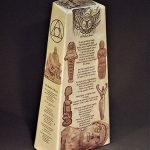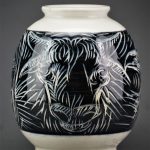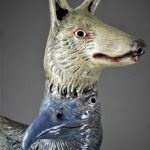FSU MFA Studio Art Alum (’10) Stephen Hawks exhibition “At the Threshold of Consciousness”
FSU MFA Studio Art Alumni (’10) Stephen Hawks‘ newest exhibition “At the Threshold of Consciousness” will be on display at the Brownsville Museum of Fine Art in Brownsville Texas January 28- February 25. Hawks’ interdisciplinary sculptural work involves the relationship of color to form; the relationship of form to will, thought and feeling; and the paradoxical nature of ideal form vs form in relation to decay, metamorphosis, and becoming. Hawks’ poetic approach to art making is anthropomorphic as it blends together tangible and spiritual influences which highlight the physicality of his materials.

Speaking of the exhibition Hawks says “The installation is somewhat based on a dream I had at least 2 decades ago. It is an altar and a hearth with a totemic work incorporating the 4 seraphic beings as well as a coyote, an American trickster being, standing in for Anubis, a spirit guide. This is flanked by 2 candle holders with candles, referencing the 2 candles in Masonic Temples, Jacob and Boaz, They are entwined by 2 monsters as described in Revelation rising up from the land and water, representing the temptations of mind and body, the physical and the sensual, Lucifer and Ahriman (The Persian name for Satan). Written on the altar are the words “That Good May Become”, a quote from Rudolf Steiner’s Foundation Stone Meditation. There is a braided rug made by my mother in front of the altar, that personalizes the piece and reiterates the idea of hearth and home. Behind the piece is a large chalk drawing on black paper of a minimalist representation of an American gothic country church floating in the stars with the tunnel of light from near death experiences above and to the right. Beside this are 4 ceramic platters, 2 on either side, with images of the seraphic beings again, also historically referred to as the 4 evangels representing Mathew, Mark, Luke, and John. It is, as all altars, indicative of a gateway to the spirit world. It is called an Elegy because it is meant to evoke an experience of great loss (but also potential) in the face of great temptations placed before America at the threshold of consciousness, in the wake of any unifying spirituality or culture, whether Indigenous, European, or otherwise. There is also intended, an echo of the Great Awakening of the late 19th century within the work.”







